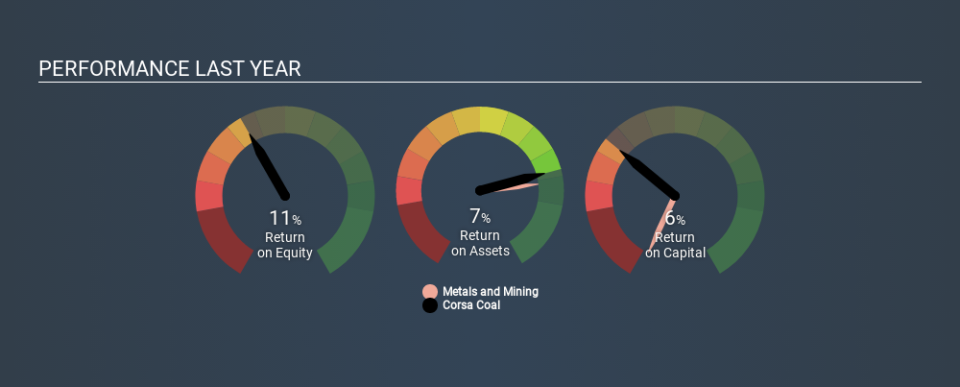Are Corsa Coal Corp.’s (CVE:CSO) High Returns Really That Great?

Today we are going to look at Corsa Coal Corp. (CVE:CSO) to see whether it might be an attractive investment prospect. To be precise, we'll consider its Return On Capital Employed (ROCE), as that will inform our view of the quality of the business.
First, we'll go over how we calculate ROCE. Next, we'll compare it to others in its industry. And finally, we'll look at how its current liabilities are impacting its ROCE.
Understanding Return On Capital Employed (ROCE)
ROCE measures the 'return' (pre-tax profit) a company generates from capital employed in its business. Generally speaking a higher ROCE is better. In brief, it is a useful tool, but it is not without drawbacks. Author Edwin Whiting says to be careful when comparing the ROCE of different businesses, since 'No two businesses are exactly alike.
So, How Do We Calculate ROCE?
The formula for calculating the return on capital employed is:
Return on Capital Employed = Earnings Before Interest and Tax (EBIT) ÷ (Total Assets - Current Liabilities)
Or for Corsa Coal:
0.06 = US$14m ÷ (US$276m - US$40m) (Based on the trailing twelve months to September 2019.)
So, Corsa Coal has an ROCE of 6.0%.
Check out our latest analysis for Corsa Coal
Is Corsa Coal's ROCE Good?
ROCE can be useful when making comparisons, such as between similar companies. Corsa Coal's ROCE appears to be substantially greater than the 3.6% average in the Metals and Mining industry. We consider this a positive sign, because it suggests it uses capital more efficiently than similar companies. Aside from the industry comparison, Corsa Coal's ROCE is mediocre in absolute terms, considering the risk of investing in stocks versus the safety of a bank account. Investors may wish to consider higher-performing investments.
Corsa Coal reported an ROCE of 6.0% -- better than 3 years ago, when the company didn't make a profit. This makes us wonder if the company is improving. You can see in the image below how Corsa Coal's ROCE compares to its industry. Click to see more on past growth.
Remember that this metric is backwards looking - it shows what has happened in the past, and does not accurately predict the future. ROCE can be deceptive for cyclical businesses, as returns can look incredible in boom times, and terribly low in downturns. This is because ROCE only looks at one year, instead of considering returns across a whole cycle. Given the industry it operates in, Corsa Coal could be considered cyclical. What happens in the future is pretty important for investors, so we have prepared a free report on analyst forecasts for Corsa Coal.
Do Corsa Coal's Current Liabilities Skew Its ROCE?
Short term (or current) liabilities, are things like supplier invoices, overdrafts, or tax bills that need to be paid within 12 months. Due to the way the ROCE equation works, having large bills due in the near term can make it look as though a company has less capital employed, and thus a higher ROCE than usual. To counteract this, we check if a company has high current liabilities, relative to its total assets.
Corsa Coal has current liabilities of US$40m and total assets of US$276m. Therefore its current liabilities are equivalent to approximately 15% of its total assets. This very reasonable level of current liabilities would not boost the ROCE by much.
What We Can Learn From Corsa Coal's ROCE
That said, Corsa Coal's ROCE is mediocre, there may be more attractive investments around. But note: make sure you look for a great company, not just the first idea you come across. So take a peek at this free list of interesting companies with strong recent earnings growth (and a P/E ratio below 20).
If you are like me, then you will not want to miss this free list of growing companies that insiders are buying.
If you spot an error that warrants correction, please contact the editor at editorial-team@simplywallst.com. This article by Simply Wall St is general in nature. It does not constitute a recommendation to buy or sell any stock, and does not take account of your objectives, or your financial situation. Simply Wall St has no position in the stocks mentioned.
We aim to bring you long-term focused research analysis driven by fundamental data. Note that our analysis may not factor in the latest price-sensitive company announcements or qualitative material. Thank you for reading.

